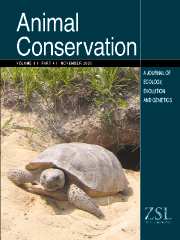Crossref Citations
This article has been cited by the following publications. This list is generated based on data provided by
Crossref.
Combreau, O.
Qiao, J.
Lawrence, M.
Gao, X.
Yao, J.
Yang, W.
and
Launay, F.
2002.
Breeding success in a Houbara Bustard Chlamydotis [undulata] macqueenii population on the eastern fringe of the Jungar Basin, People’s Republic of China.
Ibis,
Vol. 144,
Issue. 2,
Idaghdour, Youssef
Broderick, Damien
Korrida, Amal
and
Chbel, Faiza
2004.
Mitochondrial control region diversity of the houbara bustard Chlamydotis undulata complex and genetic structure along the Atlantic seaboard of North Africa.
Molecular Ecology,
Vol. 13,
Issue. 1,
p.
43.
Hingrat, Yves
Jalme, Michel Saint
Ysnel, Frédéric
Lacroix, Fredéric
Seabury, John
and
Rautureau, Pierrick
2004.
Relationships between home‐range size, sex and season with reference to the mating system of the Houbara Bustard Chlamydotis undulata undulata.
Ibis,
Vol. 146,
Issue. 2,
p.
314.
Lampen, François
Bailey, Tom A.
and
Combreau, Olivier
2005.
Medical Rehabilitation and Quarantine of Illegally Traded Macqueen's Bustard (Chlamydotis macqueenii) in the United Arab Emirates.
Journal of Avian Medicine and Surgery,
Vol. 19,
Issue. 1,
p.
35.
Tourenq, Christophe
Combreau, Olivier
Lawrence, Mark
Pole, Serguei B
Spalton, Andrew
Xinji, Gao
Al Baidani, Mohammed
and
Launay, Frédéric
2005.
Alarming houbara bustard population trends in Asia.
Biological Conservation,
Vol. 121,
Issue. 1,
p.
1.
JUDAS, JACKY
COMBREAU, OLIVIER
LAWRENCE, MARK
SALEH, MOHAMMED
LAUNAY, FREDERIC
and
XINGYI, GAO
2006.
Migration and range use of Asian Houbara Bustard Chlamydotis macqueenii breeding in the Gobi Desert, China, revealed by satellite tracking.
Ibis,
Vol. 148,
Issue. 2,
p.
343.
Hingrat, Yves
Ysnel, Frédéric
Jalme, Michel Saint
Le Cuziat, Joseph
Béranger, Pierre-Marie
and
Lacroix, Frédéric
2007.
Assessing habitat and resource availability for an endangered desert bird species in eastern Morocco: the Houbara Bustard.
Biodiversity and Conservation,
Vol. 16,
Issue. 3,
p.
597.
Hays, G.C.
Bradshaw, C.J.A.
James, M.C.
Lovell, P.
and
Sims, D.W.
2007.
Why do Argos satellite tags deployed on marine animals stop transmitting?.
Journal of Experimental Marine Biology and Ecology,
Vol. 349,
Issue. 1,
p.
52.
Hingrat, Yves
Saint Jalme, Michel
Ysnel, Frédéric
Le Nuz, Eric
and
Lacroix, Frédéric
2007.
Habitat use and mating system of the houbara bustard (Chlamydotis undulata undulata) in a semi-desertic area of North Africa: implications for conservation.
Journal of Ornithology,
Vol. 148,
Issue. 1,
p.
39.
A. Martín, Carlos
C. Alonso, Juan
A. Alonso, Javier
Palacín, Carlos
Magaña, Marina
and
Martín, Beatriz
2007.
Sex-biased juvenile survival in a bird with extreme size dimorphism, the great bustard Otis tarda.
Journal of Avian Biology,
Vol. 38,
Issue. 3,
p.
335.
A. Martín, Carlos
C. Alonso, Juan
A. Alonso, Javier
Palacín, Carlos
Magaña, Marina
and
Martín, Beatriz
2007.
Sex‐biased juvenile survival in a bird with extreme size dimorphism, the great bustard Otis tarda.
Journal of Avian Biology,
Vol. 38,
Issue. 3,
p.
335.
Carrascal, Luis M.
Palomino, David
Seoane, Javier
and
Alonso, César L.
2008.
Habitat use and population density of the houbara bustardChlamydotis undulatain Fuerteventura (Canary Islands).
African Journal of Ecology,
Vol. 46,
Issue. 3,
p.
291.
Sims, David W.
Queiroz, Nuno
Doyle, Thomas K.
Houghton, Jonathan D.R.
and
Hays, Graeme C.
2009.
Satellite tracking of the World's largest bony fish, the ocean sunfish (Mola mola L.) in the North East Atlantic.
Journal of Experimental Marine Biology and Ecology,
Vol. 370,
Issue. 1-2,
p.
127.
Dutta, Sutirtha
Rahmani, Asad R.
and
Jhala, Yadvendradev V.
2011.
Running out of time? The great Indian bustard Ardeotis nigriceps—status, viability, and conservation strategies.
European Journal of Wildlife Research,
Vol. 57,
Issue. 3,
p.
615.
Cappelle, Julien
Iverson, Samuel A
Takekawa, John Y
Newman, Scott H
Dodman, Tim
and
Gaidet, Nicolas
2011.
Implementing telemetry on new species in remote areas: recommendations from a large-scale satellite tracking study of African waterfowl.
Ostrich,
Vol. 82,
Issue. 1,
p.
17.
JENKINS, ANDREW R.
SHAW, JESSICA M.
SMALLIE, JON J.
GIBBONS, BRADLEY
VISAGIE, RONELLE
and
RYAN, PETER G.
2011.
Estimating the impacts of power line collisions on Ludwig’s Bustards Neotis ludwigii.
Bird Conservation International,
Vol. 21,
Issue. 3,
p.
303.
Magaña, Marina
Alonso, Juan C.
and
Palacín, Carlos
2011.
Age-related dominance helps reduce male aggressiveness in great bustard leks.
Animal Behaviour,
Vol. 82,
Issue. 2,
p.
203.
RIOU, SAMUEL
JUDAS, JACKY
LAWRENCE, MARK
POLE, SERGUEI
and
COMBREAU, OLIVIER
2011.
A 10-year assessment of Asian Houbara Bustard populations: trends in Kazakhstan reveal important regional differences.
Bird Conservation International,
Vol. 21,
Issue. 2,
p.
134.
Combreau, Olivier
Riou, Samuel
Judas, Jacky
Lawrence, Mark
Launay, Frédéric
and
Getz, Wayne M.
2011.
Migratory Pathways and Connectivity in Asian Houbara Bustards: Evidence from 15 Years of Satellite Tracking.
PLoS ONE,
Vol. 6,
Issue. 6,
p.
e20570.
Riou, Samuel
Combreau, Olivier
Judas, Jacky
Lawrence, Mark
Al Baidani, Mohamed Saleh
and
Pitra, Christian
2012.
Genetic Differentiation among Migrant and Resident Populations of the Threatened Asian Houbara Bustard.
Journal of Heredity,
Vol. 103,
Issue. 1,
p.
64.


